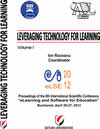CHARACTERISTICS OF THE ONLINE LEARNING ENVIRONMENT ORGANISATION. TRADITIONAL AND ELECTRONIC TEACHING
CHARACTERISTICS OF THE ONLINE LEARNING ENVIRONMENT ORGANISATION. TRADITIONAL AND ELECTRONIC TEACHING
Author(s): Letitia TrifSubject(s): Education
Published by: Carol I National Defence University Publishing House
Keywords: Roles; skills; teacher; e-learning process; learning environment; virtual teaching
Summary/Abstract: In this paper, we highlight features of the organization of online learning environment by creating a relationship of interdependence between elements of direct, traditional teaching, face to face type, and features of electronic, virtual teaching. Among the premises that we have in view, we highlight some measures and actions to implement the National Pact for Education, as the strategy for the development of education and research in the period 2009-2015, also stated in the National Education Law, no.1/2011: centring the curriculum on skills, considerably increasing curricular flexibility, introducing ICT as school subject and digitising the curriculum and creating a virtual school library, etc. Meanwhile, it is necessary to identify analysis tools for learning needs, the characteristics of students, so that the new curriculum to produce maximum cognitive profit for the students by creating an online learning community. Organizing educational activities refers to the specific methods of design and implementation of teacher-student interactions and of promoting certain types of collaboration between them in accordance with: ▪ the educational objectives pursued; ▪ the scientific content selected and processed in an accessible, attractive manner, but which also leads the pupil to cognitive and practical-active effort; ▪ the elaboration of learning self training strategy that involves establishing the type of learning experience in which students will be engaged (active, interactive, creative, heuristic, problematical, experimental), the system of teaching methods and procedures used, the system of the means of learning (with emphasis on the use of ICT and virtual libraries) and forms of organization of student activities; ▪ the determination of the structure of phases / moments of educational activities which alternate forms of traditional teaching with electronic, virtual teaching (the vision has radically changed, teaching is designed not only as an activity of communication, of conveying knowledge, but as a matter of organization and management of voluntary and autonomous learning processes, and the role of ICT is essential in this context); ▪ the establishment of evaluation and self-evaluation strategies for educational activities. At the same time, we consider necessary to identify new roles for teachers in the online teaching / learning process, by building an online learning community, and not just posting lectures on a website. For example, Paloff and Pratt list the following roles for teachers: posting objectives and expected results; the development of guidelines for participation in the online learning community; creation of learning tasks to be undertaken by collaborating online; trying to create a friendly, pleasant atmosphere by organizing teambuilding activities, ice breaking activities, etc.; initiation, monitoring, providing feedback on the direction of discussions online; mediation, solving difficult
Journal: Conference proceedings of »eLearning and Software for Education« (eLSE)
- Issue Year: 8/2012
- Issue No: 01
- Page Range: 201-207
- Page Count: 7
- Language: English

